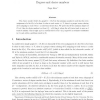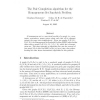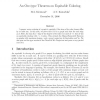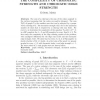93
Voted
RSA
2000
15 years 6 days ago
2000
The choice number ch(G) of a graph G = (V, E) is the minimum number k such that for every assignment of a list S(v) of at least k colors to each vertex v V , there is a proper ve...
93
Voted
IPL
2006
15 years 12 days ago
2006
A homogeneous set is a non-trivial module of a graph, i.e. a nonempty, non-unitary, proper vertex subset such that all its elements present the same outer neighborhood. Given two ...
86
Voted
JCT
2008
15 years 12 days ago
2008
A proper vertex coloring of a graph is equitable if the sizes of its color classes differ by at most one. In this note, we prove that if G is a graph such that for each edge xy E...
90
Voted
CC
2006
Springer
15 years 15 days ago
2006
Springer
The sum of a coloring is the sum of the colors assigned to the vertices (assuming that the colors are positive integers). The sum (G) of graph G is the smallest sum that can be ach...



